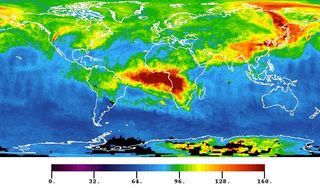What Is The Ccd In Your Digital Camera/what Does It Do?
What Is Infrared?

Infrared radiations (IR), or infrared light, is a type of radiant free energy that'southward invisible to homo eyes but that we can feel every bit heat. All objects in the universe emit some level of IR radiations, but two of the almost obvious sources are the sun and fire.
IR is a type of electromagnetic radiation, a continuum of frequencies produced when atoms absorb and and then release energy. From highest to lowest frequency, electromagnetic radiation includes gamma-rays, X-rays, ultraviolet radiation, visible light, infrared radiation, microwaves and radio waves. Together, these types of radiations brand up the electromagnetic spectrum.
British astronomer William Herschel discovered infrared light in 1800, co-ordinate to NASA. In an experiment to measure the difference in temperature between the colors in the visible spectrum, he placed thermometers in the path of light within each color of the visible spectrum. He observed an increase in temperature from bluish to ruby, and he constitute an even warmer temperature measurement but beyond the blood-red finish of the visible spectrum.
Inside the electromagnetic spectrum, infrared waves occur at frequencies higher up those of microwaves and just below those of red visible low-cal, hence the name "infrared." Waves of infrared radiations are longer than those of visible calorie-free, co-ordinate to the California Found of Engineering science (Caltech). IR frequencies range from well-nigh 300 gigahertz (GHz) upward to virtually 400 terahertz (THz), and wavelengths are estimated to range between 1,000 micrometers (µm) and 760 nanometers (two.9921 inches), although these values are not definitive, according to NASA.
Similar to the visible light spectrum, which ranges from violet (the shortest visible-light wavelength) to scarlet (longest wavelength), infrared radiations has its ain range of wavelengths. The shorter "near-infrared" waves, which are closer to visible light on the electromagnetic spectrum, don't emit any detectable heat and are what'south discharged from a Television receiver remote control to change the channels. The longer "far-infrared" waves, which are closer to the microwave department on the electromagnetic spectrum, can be felt every bit intense heat, such equally the heat from sunlight or burn down, according to NASA.
IR radiations is one of the iii ways heat is transferred from i place to another, the other two being convection and conduction. Everything with a temperature above effectually 5 degrees Kelvin (minus 450 degrees Fahrenheit or minus 268 degrees Celsius) emits IR radiation. The lord's day gives off half of its total energy as IR, and much of the star's visible calorie-free is absorbed and re-emitted as IR, co-ordinate to the University of Tennessee.
Household uses
Household appliances such as estrus lamps and toasters use IR radiations to transmit heat, as do industrial heaters such as those used for drying and curing materials. Incandescent bulbs convert only almost 10 percent of their electric energy input into visible low-cal free energy, while the other ninety per centum is converted to infrared radiation, co-ordinate to the Ecology Protection Agency.
Infrared lasers tin exist used for point-to-point communications over distances of a few hundred meters or yards. TV remote controls that rely on infrared radiation shoot out pulses of IR free energy from a calorie-free-emitting diode (LED) to an IR receiver in the TV, according to How Stuff Works. The receiver converts the light pulses to electric signals that instruct a microprocessor to carry out the programmed command.
Infrared sensing
I of the most useful applications of the IR spectrum is in sensing and detection. All objects on Earth emit IR radiation in the form of heat. This can be detected past electronic sensors, such as those used in night vision goggles and infrared cameras.
A simple example of such a sensor is the bolometer, which consists of a telescope with a temperature-sensitive resistor, or thermistor, at its focal point, according to the University of California, Berkeley (UCB). If a warm trunk comes into this instrument's field of view, the heat causes a detectable modify in the voltage across the thermistor.
Night vision cameras utilise a more sophisticated version of a bolometer. These cameras typically comprise charge-coupled device (CCD) imaging fries that are sensitive to IR lite. The image formed by the CCD can and so exist reproduced in visible light. These systems can be made small enough to be used in hand-held devices or vesture nighttime-vision goggles. The cameras tin also exist used for gun sights with or without the addition of an IR light amplification by stimulated emission of radiation for targeting.
Infrared spectroscopy measures IR emissions from materials at specific wavelengths. The IR spectrum of a substance will show characteristic dips and peaks as photons (particles of low-cal) are absorbed or emitted past electrons in molecules as the electrons transition between orbits, or energy levels. This spectroscopic information can so be used to identify substances and monitor chemical reactions.
According to Robert Mayanovic, professor of physics at Missouri State University, infrared spectroscopy, such as Fourier transform infrared (FTIR) spectroscopy, is highly useful for numerous scientific applications. These include the written report of molecular systems and second materials, such as graphene.
Infrared astronomy
Caltech describes infrared astronomy as "the detection and study of the infrared radiation (estrus free energy) emitted from objects in the universe." Advances in IR CCD imaging systems take allowed for detailed observation of the distribution of IR sources in space, revealing circuitous structures in nebulas, galaxies and the big-scale structure of the universe.
1 of the advantages of IR observation is that it can detect objects that are too cool to emit visible light. This has led to the discovery of previously unknown objects, including comets, asteroids and wispy interstellar grit clouds that seem to be prevalent throughout the galaxy.
IR astronomy is particularly useful for observing common cold molecules of gas and for determining the chemic makeup of grit particles in the interstellar medium, said Robert Patterson, professor of astronomy at Missouri Country Academy. These observations are conducted using specialized CCD detectors that are sensitive to IR photons.
Another reward of IR radiation is that its longer wavelength means it doesn't besprinkle equally much as visible light, according to NASA. Whereas visible calorie-free tin be absorbed or reflected by gas and dust particles, the longer IR waves simply become around these pocket-sized obstructions. Because of this property, IR can be used to observe objects whose light is obscured by gas and grit. Such objects include newly forming stars imbedded in nebulas or the eye of Globe's galaxy.
Boosted resources:
- Learn more than about infrared waves from NASA Science.
- Read more than nigh infrared from the Gemini Observatory.
- Watch this video describing infrared vision, from National Geographic.
This commodity was updated on Feb. 27, 2019, by Live Scientific discipline contributor Traci Pedersen.
Source: https://www.livescience.com/50260-infrared-radiation.html
Posted by: biscoecloons1986.blogspot.com



0 Response to "What Is The Ccd In Your Digital Camera/what Does It Do?"
Post a Comment